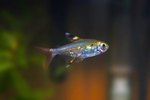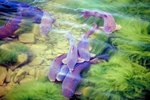
Flowerhorn cichlids are not naturally occurring species. They are hybrids, created by Malaysian fish breeders using selective breeding of several other species of cichlid. The exact species used to create these cichlids is a closely guarded trade secret, but it is believed that some of them are the three spot (Cichlasoma trimaculatum), the red devil (Amphilophus labiatus) and the redheaded cichlid (Paraneetroplus synspilus).
Description
Flowerhorn cichlids are still being developed, so a great deal of variety exists in their coloration. Generally, they are metallic green or blue on their hind end with various shades of pink and red toward the front. They have thick, oval bodies with single large humps above their eyes. Their anal and dorsal fins are pointed and long. while their caudal fins are rounded. Most have spines protruding from the rear sides of their fins.
Feeding
Flowerhorn cichlids are carnivorous fish with hearty appetites. They need to be fed two or three times daily in order to stay healthy. You can feed cichlid pellets, live krill or feeder fish, bloodworms, earthworms and crickets. It is best to feed them a variety to ensure that all their nutritional needs are met. They should never eat the meat of mammals, as they can not digest it properly; it may lead to digestive problems. Like most fish, the brightness of their coloration is affected by the foods they eat. A carotene supplement may be necessary to keep them looking their best.
Habitat
Flowerhorn cichlids do not exist in the wild, only in fish tanks. They are large fish that need plenty of room. If kept alone, an adult flowerhorn will live comfortably in a 55-gallon tank; a breeding pair needs at least 125 gallons. A mixed community tank is not recommended, but one should be no smaller than 200 gallons. Because these fish are carnivores and eat frequently, the filtration needs to be strong and the gravel needs vacuuming regularly, at least every other week. The ideal temperature is between 80 and 90 degrees Fahrenheit.
Behavior, Breeding
Flowerhorn cichlids are predatory and aggressively territorial fish. They will attack and eat anything smaller than them, including other cichlids. This makes breeding challenging. It's possible as long as the tank is large enough and the female has plenty of places to hide. When ready, the female will lay her eggs on a smooth rock or in a pit the male has dug in the gravel. After the eggs are laid, the male will swim over them, releasing his sperm. Once the eggs have been fertilized, the parents may turn on each other. If they do, remove the female from the tank. The male will guard the eggs and aerate them by fanning them with his fins. Once the eggs hatch, he will ferociously guard the fry until they are large enough to take care of themselves.
References
Photo Credits
-
Jochen Sands/Digital Vision/Getty Images
Writer Bio
Barbara Taliaferro is an animal enthusiast who lives in Ambler, Pa. She holds a Bachelor's Degree in Animal Science and has spent most of her life working with animals and the people who love them. She has been sharing her love and knowledge of animals through the written word since 2009.


